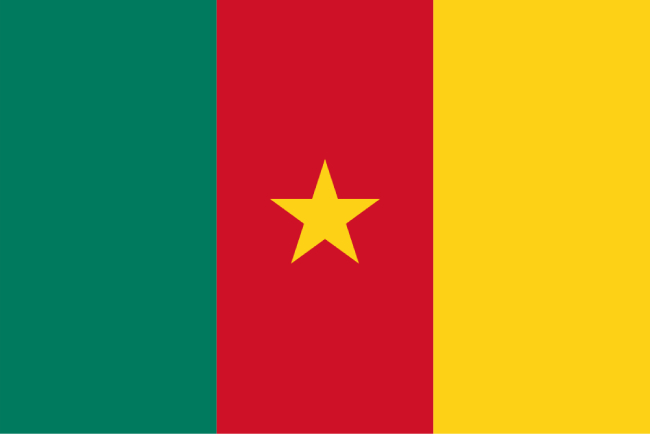Cameroon is a country in Central Africa is bordered by the Gulf of Guinea (Atlantic Ocean) in south west. Cameroon borders Nigeria in north west, the Republic of the Congo(Brazzaville), Gabon and Equatorial Guinea in south, the Central African Republic and Chad in east, and it has a narrow lakefront at Lake Chad in north.
With an area of 475,650 km², the country is almost as large as Spain or slightly larger than the US state of California. Its southern and coastal areas are characterized by dense vegetation, a vast river system and a hot, humid climate with abundant rainfall.
Largest city is Douala, the country’s main port and economic capital with its commercial and industrial activities, Yaounde is the second largest city and the political capital of Cameroon.
Other major urban centers are Edea, characterized by its heavy industry and its hydro-power plant, Limbe, headquarters of the oil industry and Kribi terminal of the Chad-Cameroon pipeline.
Cameroon has a population of 24 million people (in 2016), English and French are
official languages, however French is by far the most commonly used language.
Background at Cameroon
The name Cameroon is derived from the Portuguese word, Camaroes, meaning shrimps. As Portuguese sailor Ferdanando Poo arrived in 1472 at the Wouri river in Douala and discovered so many shrimps in the river he decided to call it Rio Dos Camaroes (River of shrimps, in Portuguese). It was from this word that the territory derived its name which is now spelt in various forms: Spanish spelt it Cameroes; Germans, Kamerun; English, Cameroon; and French, Cameroon.
The territory was colonized by the Germans in 1884 but after the end of the First World War Cameroon was mandated by the League of Nations to the French and British governments. France took the greater sector, formally known as East Cameroon, while Britain took responsibility over former West Cameroon known then as “Cameroon under British Administration”.
On January 1st 1960 the French Sector became independent under the new name of Cameroon Republic. Following agitation for independence by the Southern Cameroons – before the name was changed to West Cameroon – a plebiscite was held in that sector of Cameroon on February 11th 1961 under the United Nations supervision. The result of the plebiscite was overwhelming for reunification (233,571 against 97,741) and gave Southern Cameroon automatic independence and unification, which was achieved on 1 October 1961. Thus after the reunification of both sectors, the Federal Republic of Cameroon was born.
After a referendum in May 1972, Cameroon became a United Republic and by a Presidential
Decree of 1984 it became the Republic of Cameroon.
Business & Economy in Cameroon
Because of its oil resources and favorable agricultural conditions, Cameroon has one of the bestendowed primary commodity economies in sub-Saharan Africa. Still, it faces many serious problems such as stagnant per capita income, a relatively inequitable distribution of income, a top-heavy civil service, endemic corruption, and a generally unfavorable climate for business enterprise.
Geography of Cameroon
Location: Central West Africa bordering the Bight of Biafra (part of the Gulf of Guinea and the Atlantic Ocean).
Area: 475,650 km² (183,650) sq. mi.).
Terrain: Northern plains, central and western highlands, southern and coastal tropical forests. Highest peak: Mt. Cameroon (13,353 ft.).
Climate: Northern plains, the Sahel region–semiarid and hot (7-month dry season);
Central and western highlands where Yaounde is located–cooler, shorter dry season; southern tropical forest–warm, 4-month dry season; Coastal tropical forest, where Douala is located– warm, humid year-round.
People of Cameroon
Nationality: Cameroonian(s); French noun and adjective–Camerounais(e).
Population: 24 million. (2016)
Ethnic Groups: About 250.
Languages: French and English (both official) and about 270 African languages and dialects, including pidgin, Fulfulde, and Ewondo.
Religions: Christian 53%, Muslim 22%, indigenous African 25%.
Literacy: 75%
Natural Resources of Cameroon
Oil, timber, hydroelectric power, natural gas, cobalt, nickel.
Agricultural Products of Cameroon
Timber, coffee, tea, bananas, cocoa, rubber, palm oil, pineapples, cotton.
Industries in Cameroon
Petroleum production and refining, aluminum production, food processing, light
consumer goods, textiles, lumber, ship repair.
Exports – Commodities in Cameroon
Crude oil and petroleum products, lumber, cocoa beans, aluminum, coffee, and cotton.
Exports Partners of Cameroon
China 16.7%, India15.7%, Spain 6.2%, Belgium 6.1%,France 6.1%, Portugal 5.6%,Netherlands 5%, Italy 5% (2015)
Imports – Commodities in Cameroon
Machinery, electrical equipment, transport equipment, fuel, food, cereals, fish.
Imports – Partners of Cameroon
China 27.9%, Nigeria13.9%, France 10.9%, Belgium 4.1% (2015)
Currency of Cameroon
Communaute Financiere Africaine franc (XAF)
CENTER FOR AFRICAN STUDIES
Center for Africa Studies (AFRAM) which located in Ankara, is an organization facilitating under the administration of African Affairs Council (AFAC). It makes various researches about Africa to enhance economic and cultural bounds between Africa and Turkey. AFRAM’s publishings has been shared with different institutions as they require to obtain.
AFRICA OBSERVATORY
Africa Observatory is one the publishing of AFRAM and it has been published each two weeks. It has been delivered to different institutions via e-mail.






